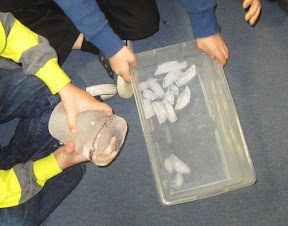Sensory table explorations of matter
By Peggy Ashbrook
Posted on 2013-12-19
 Experiences are the beginning of understanding science and engineering concepts. When two-year-olds explore materials and make a mixture, they are learning about the properties of “matter.” Water is a favorite kind of matter for many children and adults. In warm weather, programs often make large amounts of water available for children to work with and most children don’t mind being wet. In colder weather when getting wet means having to change clothes, adults prefer that children work with smaller amounts of liquid water or frozen water. Changing clothes or getting dressed to go outside in cold or wet weather is a significant learning experience and a challenge for those children still mastering sleeves and zippers. Instead of thinking of this process as something to get through and done with, we can embrace the time as a time for learning.
Experiences are the beginning of understanding science and engineering concepts. When two-year-olds explore materials and make a mixture, they are learning about the properties of “matter.” Water is a favorite kind of matter for many children and adults. In warm weather, programs often make large amounts of water available for children to work with and most children don’t mind being wet. In colder weather when getting wet means having to change clothes, adults prefer that children work with smaller amounts of liquid water or frozen water. Changing clothes or getting dressed to go outside in cold or wet weather is a significant learning experience and a challenge for those children still mastering sleeves and zippers. Instead of thinking of this process as something to get through and done with, we can embrace the time as a time for learning.
Teachers can expand the learning at clothes-changing time in many ways, including:
- Teaching vocabulary words in more than one language for items of clothing, (some websites allow a small free trial of common words)
- Learning (or adapting) a few songs or poems about getting dressed and singing them while dressing or undressing. Learn some by watching the marvelous collection of video clips by librarians from the King County Library System in Washington state which includes, “I’m Going to Wear a Sweater,” “Put Your Pants On,” and “Dressed in the Morning.”
- Have children who are dressed help others pull on socks or zip up zippers.
- Providing an activity, such as drawing, for children who are waiting for everyone else to get dressed. Tape large pieces of cardboard from boxes to the wall and provide washable markers.
- Having “getting to know you” conversations about what children did at home the evening before.
Water may be a favorite, but other kinds of matter can also be explored in a sensory table. See the articles from Young Children, the journal of the National Association for the Education of Young Children:
“Teachers on Teaching: What Happens When a Child Plays at the Sensory Table?” By Debra Hunter (November 2008, pgs 77-79).
“Let’s Get Messy! Exploring Sensory and Art Activities with Infants and Toddlers” By Trudi Schwarz and Julia Luckenbill (September 2012, pgs 26-34).
Pinterest accounts and blogs are another source for ideas that might work with the age children that you teach. See Debra Honegger’s Pinterest “board” of ideas for sensory experiences.
The “irresistible ideas for play based learning” blog documents how children engaged with coffee grounds, corn starch and water over a two-day period.

Evaluate the activities for safety and age appropriateness in your program with your children. Have children wash hands before playing with a tub full of ice cubes or snow, and provide another tub of warm water to prompt comparisons between the cold, solid ice and the warm, liquid water. If the weather gets cold enough, children can observe frozen water outside. In warm weather, bring ice cubes outside and have children choose places for their cube to melt.
Surprisingly, many preschool children aren’t sure what water ice is made of. With additional melting and freezing experiences they will build the knowledge that water can be in liquid form and it can be in solid form. Discussion with adults who prompt thinking with open-ended questions such as, “Where else have you seen frozen water?” and “What can we do to change this solid ice into liquid water?” is an important part of science learning.
Disclaimer: The views expressed in this blog post are those of the author(s) and do not necessarily reflect the official position of the National Science Teaching Association (NSTA).

